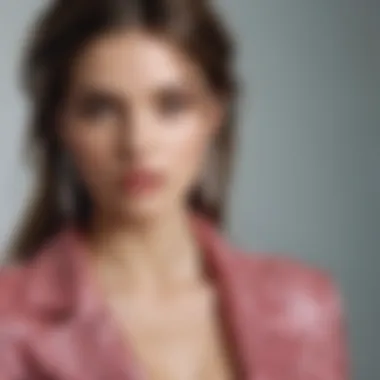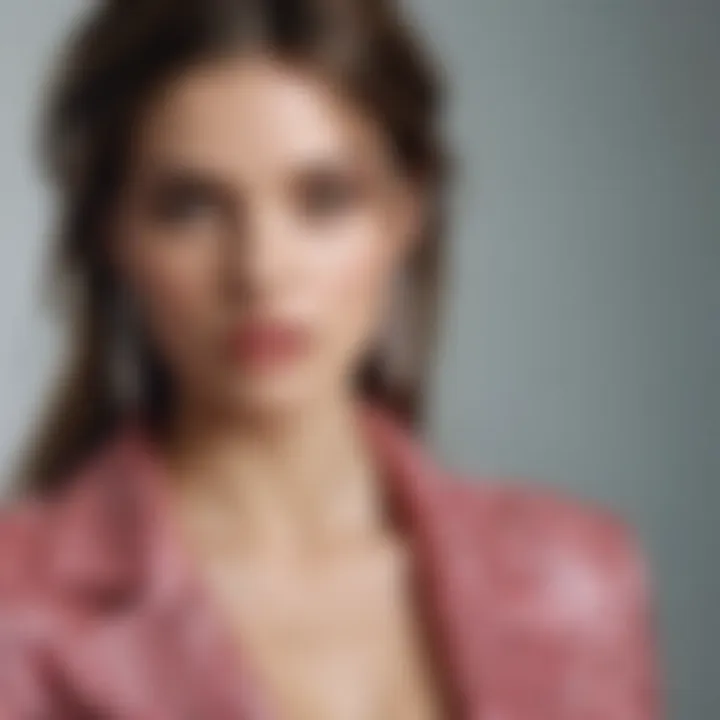Exploring Women’s Fashion Trends of the Early 2000s


Intro
The early 2000s represent a distinct and dynamic chapter in the evolution of women's fashion. This period was characterized by a vibrant blend of various cultural influences, technological advancements, and shifting social norms. From music videos to reality television, the media played a significant role in shaping fashion choices, making the decade a rich tapestry of diverse styles. Understanding this intricate landscape allows us to appreciate how these trends not only defined an era but also laid the groundwork for contemporary fashion.
In this article, we will explore the essential components that defined women's fashion during the early 2000s, including key trends, the influence of celebrities, and the emergence of iconic styles. By delving into the foundational aspects of beauty, grooming, and sustainable practices, we illuminate how past influences remain relevant in today's fashion landscape.
Let’s open with a discussion regarding the basics of personal care that served as the foundation for women’s fashion choices in this period.
Preamble to Early 2000s Fashion
The early 2000s marked a distinctive era in women's fashion that encapsulated a blend of innovation and cultural shifts. Understanding this period is essential as it laid the groundwork for many contemporary styles we see today. The early 2000s introduced a unique aesthetic that was both playful and experimental. Women’s fashion became a reflection of individual expression, often influenced by a variety of factors including pop culture and societal changes.
As we delve deeper into this topic, we will explore how these trends emerged and evolved, focusing on their relevance in today’s fashion landscape. This critical examination not only highlights key styles and trends but also provides insight into the societal context that shaped women's choices in clothing. By revisiting these trends, we can better understand our current fashion sensibilities and the cyclical nature of style.
Historical Context
The early 2000s were characterized by significant social and technological changes. The advent of the internet began to reshape how fashion was consumed and understood. Online shopping became popular, and social media started to gain traction as a means for sharing trends and styles.
This period also witnessed the rise of celebrity culture. Icons in music and film began to have a profound influence on clothing choices. It symbolized not just fashion, but a broader cultural transformation. Women began to embrace a mix of styles that encompassed casual wear, street fashion, and elements of high fashion, thereby creating a diverse wardrobe palette.
Influence of Pop Culture
Pop culture acted as a significant catalyst for trend creation in the early 2000s. The influence of television, movies, and music could be seen in the daily attire of women. Programs like "Friends" and "Sex and the City" became pivotal in defining style and setting trends. These shows pushed the envelope, encouraging women to experiment with fashion rather than conforming to specific styles.
Music also played a role. Artists like Britney Spears and Beyoncé became fashion icons, and their looks were often emulated by fans. The multi-dimensional nature of pop culture, combined with the rise of celebrity status, resulted in an eclectic mix of styles. This period wasn’t just about clothing; it was about how women presented themselves, creating a lasting impact that would influence future generations.
Key Trends of the Early 2000s
The early 2000s was a transformative time in women's fashion. This period saw a blend of styles that reflected broader societal changes. Technology advanced rapidly, influencing how fashion was produced and consumed. The importance of understanding key trends from this area lies in grasping how these ideas shaped contemporary fashion. Each element, from casual wear to accessories, played a significant role in defining the era.
Low-rise Jeans and Baggy Styles
Low-rise jeans emerged as a defining trend in the early 2000s. These jeans typically sat below the hip, offering a relaxed fit. The popularity of low-rise jeans can be attributed to their association with figures like Britney Spears and Paris Hilton. Often worn with crop tops, they allowed for personal expression and comfort. Baggy styles complemented this trend, with oversized clothing becoming common. Women favored loose shirts and wide-leg pants, contributing to an effortless look that still aimed for chic.
Graphic Tees and Logo-driven Fashion
Graphic tees became essential in the early 2000s wardrobe. Featuring band logos, witty phrases, or striking graphics, these shirts allowed individuals to showcase their interests. Brands like Abercrombie & Fitch dominated this market. Logo-driven fashion also gained traction, with items like Louis Vuitton bags adorned with clear branding. This not only made items sought after but demonstrated loyalty to certain lifestyle brands, reflecting the social dynamics of the time.
Bold Color Palettes
The color choices in early 2000s fashion were anything but muted. Bright colors and bold patterns were everywhere. Neon greens, hot pinks, and vivid yellows invaded the runways and street wear alike. This energetic palette was a response to the growing influence of pop culture. Women utilized these colors not only to stand out but also to express their mood. The vibrancy of this period set it apart from the more subdued tones of previous decades.
The Rise of Couture Streetwear
Streetwear transitioned significantly during the early 2000s. While the origins stem from urban culture, couture elements began to merge with everyday wear. High-end brands like Marc Jacobs introduced street-inspired clothing into their collections. The movement towards blending comfort and luxury appealed to many women. This amalgamation showcased the idea that high fashion could be accessible, indicating a shift in how fashion was perceived and consumed. Effortless chic became the desired look as individuals sought styles that combined ease with sophistication.
"Fashion in the early 2000s was not just about clothing; it was a statement of identity and belonging."
These key trends collectively illustrate how the early 2000s marked a pivotal moment in women's fashion. The era reflected a blend of individualism, cultural influences, and a bold approach to style that continues to resonate today.
The Role of Celebrities in Fashion Trends
In the early 2000s, celebrities played a pivotal role in shaping women's fashion. Their influence extended beyond mere admiration; it created a significant cultural shift. As the media spotlight intensified, stars became trendsetters, impacting what women wore and how they expressed themselves. This phenomenon can be attributed to various factors, including media representation, the rise of social platforms, and the intrinsic relationship between celebrity culture and consumerism. The depiction of these icons in magazines, on television, and later online, fueled the demand for similar styles among the public.
Influencers and Their Impact


During the early 2000s, the concept of influencers was not as formally recognized as it is today, yet several celebrities acted as precursors. The likes of Paris Hilton and Nicole Richie heralded a new wave of socialites who captivated audiences with their fashion choices. The attention from paparazzi stories and red-carpet appearances showcased their unique styles, making trends instantly accessible to the masses. Photographs in Teen Vogue or Cosmopolitan had the power to turn a specific dress, handbag, or hairstyle into must-haves.
Moreover, reality TV opened doors for personalities to showcase their lifestyles, further paving the way for fans to engage and emulate their style choices. This direct connection amplified the message that celebrity fashion was attainable. The idea of dressing like a star became ingrained in popular culture, altering the way women approached their wardrobes.
Fashion Icons of the Era
Numerous celebrities emerged as fashion icons during this timeframe. Notable figures include Britney Spears, Jennifer Lopez, and Gwen Stefani, among others. Their distinctive styles defined and diversified fashion choices. The iconic red carpet looks often became benchmarks within the fashion world.
- Britney Spears: Known for her baby tee paired with low-rise jeans, she encapsulated the youthful spirit of the decade.
- Jennifer Lopez: Her green Versace dress at the 2000 Grammy Awards is a moment remembered for both its risqué nature and its significant impact on celebrity fashion.
- Gwen Stefani: She merged punk influences with high fashion, inspiring young women to express individuality through eclectic combinations.
These icons did not merely follow trends; they initiated cultural dialogues around style, femininity, and personal expression. Women of all ages sought to replicate their looks, demonstrating the profound connection between celebrity culture and consumer behavior during this era. Celebrity endorsement has since become a hallmark of fashion marketing, starting considerably during this transformative period.
"Fashion is a way to say who you are without having to speak." - Rachel Zoe
Understanding the impact of celebrities on fashion trends in the early 2000s illuminates how culture and commerce intertwined, shaping contemporary fashion landscape.
Signature Accessories of the Early 2000s
The early 2000s was a distinctive period in fashion that celebrated bold expressions through accessories. During this time, accessories were not merely additions to a look but were essential components that communicated personal style. The role of signature accessories in this era cannot be overstated. They served to enhance outfits, reflect individual identities, and create memorable fashion statements. Understanding these accessories provides insight into the overarching trends and social dynamics of the time.
Chunky Jewelry and Statement Pieces
Chunky jewelry emerged as a dominant trend in the early 2000s, characterized by oversized bangles, large hoop earrings, and intricate necklaces. This style preference was often driven by a desire for self-expression and a move away from the minimalist aesthetics of the previous decade. Pieces were often colorful, mixing materials such as plastic, metal, and glass.
Women favored layering multiple pieces to create a bold look. The idea was to make a statement; the bigger and bolder, the better. For example, wearing large earrings with a simple top or layering multiple bangles over long-sleeved tops became common practices. This trend also included novelty items, such as charm bracelets that would tell a story or represent personal interests.
The appeal of chunky jewelry lay in its power to transform an outfit. An otherwise simple ensemble could receive an instant upgrade with the right accessories. Other notable examples included necklaces featuring large pendants and rings adorned with colorful stones. These accessories not only made a fashion statement but also became conversation starters.
Handbags and Their Evolution
Handbags in the early 2000s reflected changes in lifestyle and attitudes towards fashion. The silhouette of bags varied greatly during this period, from oversized totes to small clutches. The most popular styles often bore logos prominently, as brands like Louis Vuitton and Gucci made their designs nearly ubiquitous.
The rise of the “it” bag was significant, with many women gravitating toward high-ticket items that signified status. The contrast between everyday practicality and luxury created a fascinating dynamic in handbag choices. Many women sought to balance functionality with fashion, leading to the popularity of messenger bags and backpacks that were both stylish and practical.
In addition, the use of innovative materials allowed for creative designs. Handbags made from non-traditional fabrics such as canvas, rubber, and synthetic materials became common as well. The versatility of these designs made them appealing to a wider audience.
The evolution of handbags in the early 2000s epitomized the balance of chic and practical, influencing how women approached their wardrobes.
As we analyze these accessories, we see a broader picture emerge of women’s fashion during the early 2000s. The choices made reflected not just style preferences but also deeper societal attitudes and aspirations.
Skirts and Dresses: Defining Styles
Skirts and dresses played a pivotal role in shaping women's fashions during the early 2000s. The era was marked by a blend of comfort and exuberance. These styles were not just garments, they expressed individuality and a spirit of rebellion. Significantly, the fabrics, lengths, and patterns of trends contributed to the vast array of choices available at that time. Such versatility in skirts and dresses impacted women’s fashion in their daily lives and special occasions alike.
Mini Skirts and Layering
The mini skirt reigned supreme in the early 2000s fashion landscape. It became a symbol of liberation and playfulness. Often worn with leggings or tights, these outfits showcased the art of layering, which was particularly popular. Layering not only added depth to a look but also allowed for personal expression through color and texture combination.
Popular brands like Abercrombie & Fitch and American Eagle Outfitters introduced playful options that appealed to a younger demographic. The appeal of skirts during this period lies in their ability to effortlessly transition from casual daywear to night out attire.
"A mini skirt paired with a graphic tee defines a casual-chic look that remains iconic."
Women of various ages embraced this trend, featuring chic prints or solid colors. Mini skirts provided a vibrant canvas that energized any outfit, showcasing youthful exuberance.
Slip Dresses: A Fashion Staple
Slip dresses emerged as a quintessential style in the early 2000s. These dresses created a sensation due to their simplicity and elegance. Often made of silk or satin, they offered a luxurious feel while allowing for versatile layerings, such as oversized jackets or cardigans.


Slip dresses could easily transition from day to night, making them a staple in any woman’s wardrobe. Celebrities like Jennifer Aniston elevated this style, wearing them effortlessly on red carpets. Brands like Free People made them widely accessible to the everyday woman, encapsulating the need for both style and comfort.
The allure of the slip dress lies in its minimalist appeal, ideal for women seeking an understated yet refined look. Whether adorned with statement jewelry or left unembellished, these dresses encapsulated personal style while remaining rooted in a broader fashion narrative. Overall, skirts and dresses during the early 2000s allowed women to navigate their identity in an era defined by bold expressions.
Working Style: Fashion in Professional Settings
Fashion in professional settings during the early 2000s presented a very interesting transition. The way women dressed for work was evolving, influenced by various cultural shifts and societal standards. Working women sought to maintain a professional image while balancing personal style and comfort. This blend of functionality and fashion became essential in defining work attire.
Blazers and Tailored Pants
Blazers stood as a cornerstone of professional wardrobes. The fitted blazer crafted from structured fabric offered a polished look. Often paired with tailored pants, this combination was favored for its sharp silhouette. The colors of blazers ranged widely from classic blacks and navies to more adventurous hues like deep reds and greens, providing versatility.
Tailored pants complemented the blazers perfectly. They typically featured a high waist and sleek cut, extending to the ankle or slightly below. This style emphasized a woman’s shape without compromising on professionalism. Such ensembles conveyed authority and confidence in the workplace.
In addition, the importance of quality materials in this attire cannot be overlooked. Fabrics like wool and cotton blends added comfort while ensuring that the garments maintained their shape. The right fit was critical; women often turned to tailors or sought brands known for their fit and quality. This focus on tailoring highlighted the significance of dressing well within the work environment.
The Shift towards Casual Wear
The early 2000s also marked a notable shift towards casual wear in professional settings. As companies began to embrace more relaxed dress codes, the lines between formal attire and everyday clothing blurred. This change made room for more personal expression while maintaining a sense of professionalism.
Casual wear in the workplace included elements such as khakis, high-quality denim, and even smart casual shirts. Women opted for blouses paired with dressy jeans or slacks instead of solely relying on blazers and tailored pants. The emphasis shifted towards a dress code that encouraged comfort, especially as the gig economy and flexible work arrangements grew in popularity.
While this shift was refreshing, it brought with it considerations regarding appropriateness. Women had to navigate the fine line of looking professional while leveraging new freedoms in dressing. This evolved fashion trend highlighted individual styles and preferences while remaining mindful of workplace expectations.
"Fashion is not just about clothes. It is about how you feel in your environment."
Understanding the transformation of working fashion during the early 2000s reveals much about broader cultural trends. The blending of formal and casual wear was a reflection of changing attitudes towards women's roles in the workplace and society. As women navigated their identities and professional aspirations, their choices in work attire continued to evolve.
Footwear Trends of the Early 2000s
Footwear in the early 2000s played a significant role in shaping overall fashion of the decade. The shoes worn not only complemented outfits but also marked personal style. This section explores the popular trends in footwear, emphasizing their relevance and impact on women's fashion.
Platforms and Chunky Shoes
Platform shoes emerged powerfully in the early 2000s. They were known to elevate the wearer, both physically and stylistically. The chunky soles provided comfort while enhancing the height. Many platforms featured bright materials and bold colors, making them statement pieces in any outfit. Iconic brands like Steve Madden were key players in this trend, offering various styles that appealed to a diverse audience.
The versatility of platform shoes allowed them to be worn across different contexts. From casual outings to parties, these shoes were adaptable. A popular choice among women was pairing them with low-rise jeans or mini skirts. This combination underscored the youthful and vibrant spirit of the era, making platforms essential in early 2000s women's wardrobes.
"Platform shoes were a clear statement of confidence, providing both elevation and a unique flair to outfits."
Sneakers and Athletic Wear
Sneakers also gained immense popularity during this decade. With the growing influence of athletes and fitness, women gravitated towards comfortable and stylish athletic wear. Brands like Nike and Adidas offered trendy designs that resonated with the public's interest in casual yet chic attire.
Sneakers were not merely for workouts; they became a staple in everyday wear. Women combined sporty sneakers with various outfits, from dresses to tailored pants, demonstrating the versatility of this footwear. The trend shifted towards a blend of functionality and fashion, making athletic shoes a defining element of the early 2000s. This footwear trend marked a transition towards a more relaxed form of dressing, where comfort took precedence without sacrificing style.
The impact of this transition can still be seen today, as the influence of early 2000s athletic wear continues to motivate contemporary fashion choices.
Sustainable Fashion Developments
Sustainable fashion emerged as a significant topic in the early 2000s, aligning with a growing awareness of environmental issues. This period marked a shift in consumer thinking, prioritizing not just aesthetics but also the impact of fashion choices on the planet. The developments in sustainable fashion during this time laid the groundwork for shifts in consumer attitudes and industry practices that are still relevant today.
Focusing on sustainable fashion involves examining several key elements that underscore its importance. The fashion industry is recognized as one of the largest polluters, prompting calls for eco-friendly practices. The incorporation of sustainable materials such as organic cotton and recycled fabric began to gain momentum. These materials not only offered alternatives to traditional textiles but also represented a more responsible approach towards production. Moreover, the notion of ethical manufacturing, which includes fair wages and safe working conditions for workers, began to take precedence.
The benefits of sustainable fashion are multifaceted. From reducing waste to minimizing environmental impact, adopting sustainable practices can lead to a significant transformation in how clothing is produced. Additionally, there is a growing market among consumers who are willing to invest in brands that prioritize sustainability and ethical practices. By fostering awareness about the implications of fast fashion, the early 2000s contributed to a better-informed audience, which became crucial in driving demand for sustainable options.
Considerations about sustainable fashion developments include the need for transparency in the supply chain. Consumers in the early 2000s began to seek information about where materials were sourced and how garments were made. This demand for transparency has only increased in the subsequent years, leading many eco-friendly brands to highlight their practices and policies prominently.


"Sustainable fashion is not just a trend; it reflects a significant shift in the way we think about clothing and its value."
Overall, the emergence of sustainable fashion developments in the early 2000s served as both a response to ecological concerns and a foundation for what was to come in the future of fashion. It has paved the path for current practices that aim to marry style with sustainability, ensuring that fashion continues to evolve responsibly.
Emergence of Eco-friendly Brands
The turn of the millennium witnessed the rise of eco-friendly brands that prioritized both fashion and sustainability. Many of these brands focused on using recycled materials, reducing waste, and maintaining ethical labor practices. Notable examples include:
- ECOALF: Founded in 2009, this company is known for creating high-quality fashion from discarded materials, setting a standard for eco-conscious branding.
- People Tree: Established much earlier, in 1991, People Tree advocated for fair trade and sustainable production far ahead of many competitors.
The significance of these brands cannot be understated. They not only offered consumers stylish alternatives but also educated them about the importance of making environmentally conscious choices. As these brands gained traction, they inspired larger companies to rethink their practices, ultimately initiating a broader change in the fashion landscape.
These movements in sustainable fashion continue to influence how brands operate. The call for eco-friendly practices remains a pivotal conversation today, demonstrating the lasting impact of early 2000s developments.
Legacy of Early 2000s Fashion
The legacy of early 2000s fashion remains significant in contemporary style discussions. This period was marked by bold choices that challenged conventions and inspired future generations of designers and fashion enthusiasts. Understanding this legacy helps to appreciate how past aesthetics inform current fashion narratives. It is crucial to recognize the elements that defined the early 2000s, as they contribute to a broader understanding of fashion evolution.
One notable aspect of this legacy is the vibrant blend of street and high fashion. The rise of couture streetwear blurred distinctions between casual and formal wear. This interaction has laid the foundation for many current fashion trends, where comfort meets luxury. Low-rise jeans, graphic tees, and baggy silhouettes made statements about personal expression and individuality, shaping the identity of many young women at the time. Today, these elements resonate within the closets of women seeking both style and comfort.
The cultural relevance of early 2000s fashion is further reinforced by its continual resurgence within popular media. Films, music videos, and social platforms have revisited the styles of this era, often showcasing nostalgia and reinterpreting these looks. The relationship between fashion and media in the early 2000s showcases a symbiotic dynamic that continues to influence designers. Acknowledging this interplay encourages an appreciation of how fashion reflects not just personal style but also societal sentiments.
Moreover, the early 2000s introduced significant discussions around body image and self-expression. Unlike previous eras that often prescribed specific body types, this time embraced diverse representations. Women were encouraged to experiment with their looks, and this sense of freedom is crucial today. The key takeaway is that this decade not only shaped aesthetic preferences but also impacted the broader conversation about empowerment through fashion.
The styles of the early 2000s serve as a reminder that fashion is an evolving conversation, reflecting cultural shifts and personal stories.
In summary, the legacy of early 2000s fashion is multifaceted, characterized by innovation, inclusivity, and the merging of various influences. Recognizing its impact on contemporary fashion helps women of all ages to understand the roots of today's trends and promotes a deeper engagement with their wardrobe choices.
Resurgence in Contemporary Fashion
The resurgence of early 2000s fashion in contemporary settings illustrates a fascinating cycle of style evolution. This revival can be seen in various forms; from the reintroduction of low-rise jeans to the popularity of chunky sneakers. Such pieces have not only re-entered retail spaces but have also been embraced by influencers and celebrities who resonate with this era.
Many brands have capitalized on this nostalgia, offering reimagined versions of iconic styles. For instance, Bella Hadid and Kendall Jenner have been spotted in outfits reminiscent of early 2000s aesthetics, promoting trends that once defined a generation. This blending of old and new appeals to both younger demographics and those who lived through the period.
Social media has also played a critical role in this revival. Platforms like Instagram and TikTok allow users to share their takes on vintage styles, sparking trends that quickly circulate among global audiences. Hashtags related to early 2000s fashion often see substantial engagement, serving as a reminder of the decade’s lasting influence.
This resurgence restores a sense of individuality and creativity to wardrobe choices, encouraging personal expression akin to that of the early 2000s wearer. The cultural embrace of these styles reflects how they embody emotional connections and memories tied to that period. Recognizing this phenomenon provides insights into how women navigate fashion in today's society, blending nostalgia with personal identity.
Cultural References and Revivals
Cultural references play an intricate role in the revival of early 2000s fashion. Media portrayals often evoke strong sentiments linked to nostalgia, creating a fertile ground for fashion trends to resurface. Significant cultural artifacts from this era, such as films, music, and television series, have contributed to reimagining and revived interest in past styles.
For instance, films like "Mean Girls" or series like "Friends" cemented various fashion trends within popular culture. Their iconic looks serve as a reference point for both designers and consumers today. Recognizing these cultural references aids in understanding why certain styles re-emerge, sometimes altered but still echoing the past.
Another aspect to consider is the role of internet culture and the accessibility of fashion history via platforms like Reddit and Instagram. Here, users share and discuss their favorite early 2000s looks. This aggregation of knowledge and style not only keeps memories alive but allows for creative reinterpretation by new generations of fashion lovers.
The exploration of cultural references in this context encourages a dynamic discussion about identity and aesthetics. It bridges the gap between past and present, allowing today's women to craft their narratives while honoring the styles that inspired them. This continuous dialogue between heritage and modernity fosters a vibrant fashion ecosystem that is both reflective and forward-thinking.
End
The examination of women's fashion in the early 2000s reveals the complexities of an era marked by rapid cultural shifts and evolving styles. This decade witnessed a unique blend of influences that shaped not only fashion but also broader societal norms. With trends such as low-rise jeans, graphic tees, and bold accessories, the early 2000s provided women with a vast array of choices that reflected individuality as well as conformity.
Reflections on Impact and Influence
Understanding the impact of this period offers significant insights into contemporary fashion. Many elements from the early 2000s have resurfaced in modern wardrobes, signaling a revival of interest in past styles. The willingness of current designers to incorporate retro items demonstrates a cycle of influence that is fundamental to fashion.
This cycle urges us to reflect on our personal style and how it may be shaped by cultural memory, media influence, and nostalgia. The resurgence of certain trends suggests that women today still seek to express identity and status through clothing. Moreover, it reminds us how fashion can serve as a testament to the times, paralleling shifts in attitudes toward body image, professional attire, and sustainability.
"Fashion reflects what's happening in society. It is a mirror of our cultural values."
The early 2000s thus signify a pivotal moment for women's fashion, defined by both empowerment and commercialism. The legacy of this decade continues to influence and shape current trends, demonstrating fashion's dynamic nature. As we move forward, understanding such influences equips consumers and designers alike, facilitating informed choices about style and sustainability.
In summary, the conclusion emphasizes the rich tapestry created by early 2000s fashion, revealing its lasting impact on modern aesthetics and societal norms.







